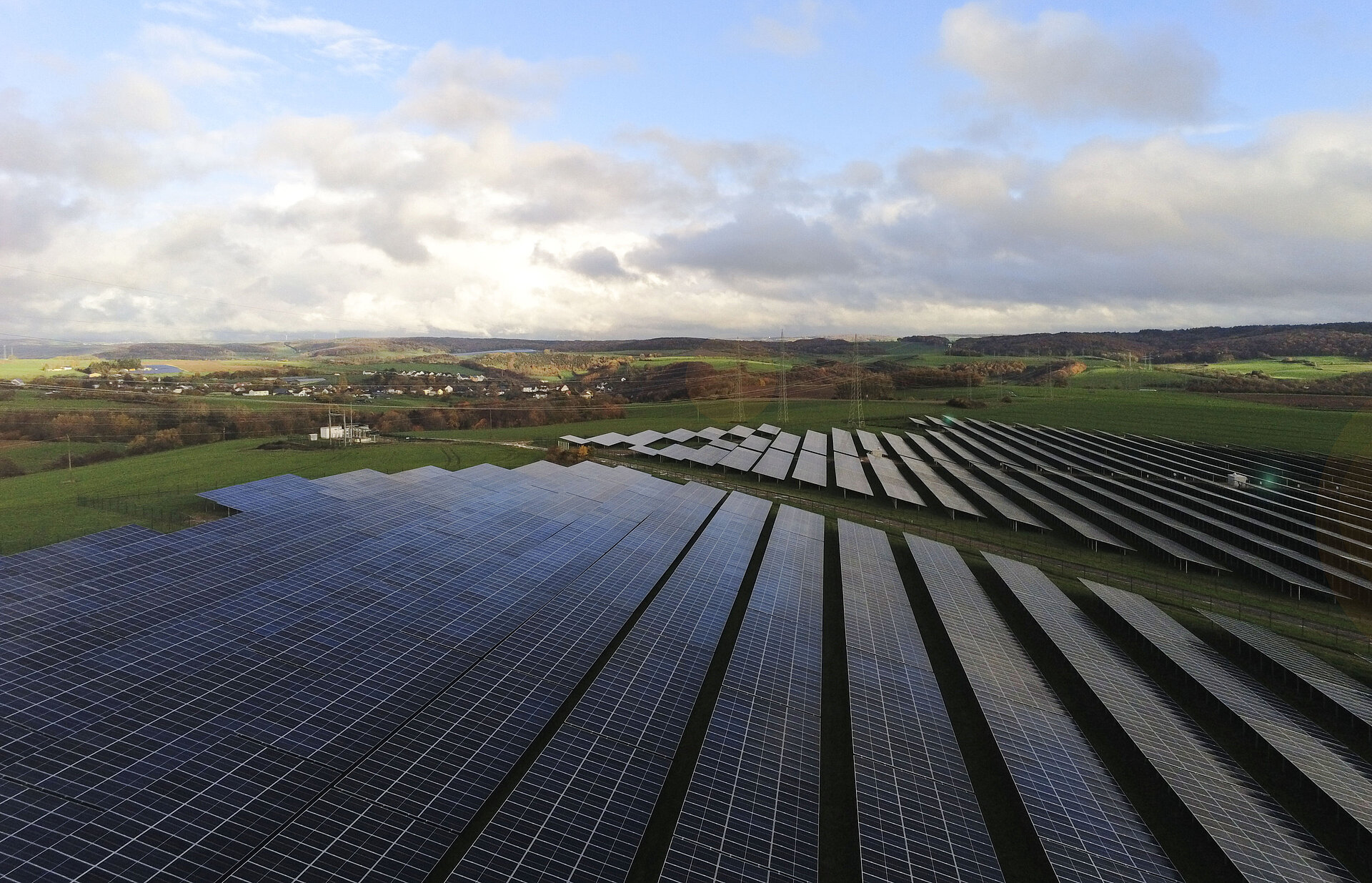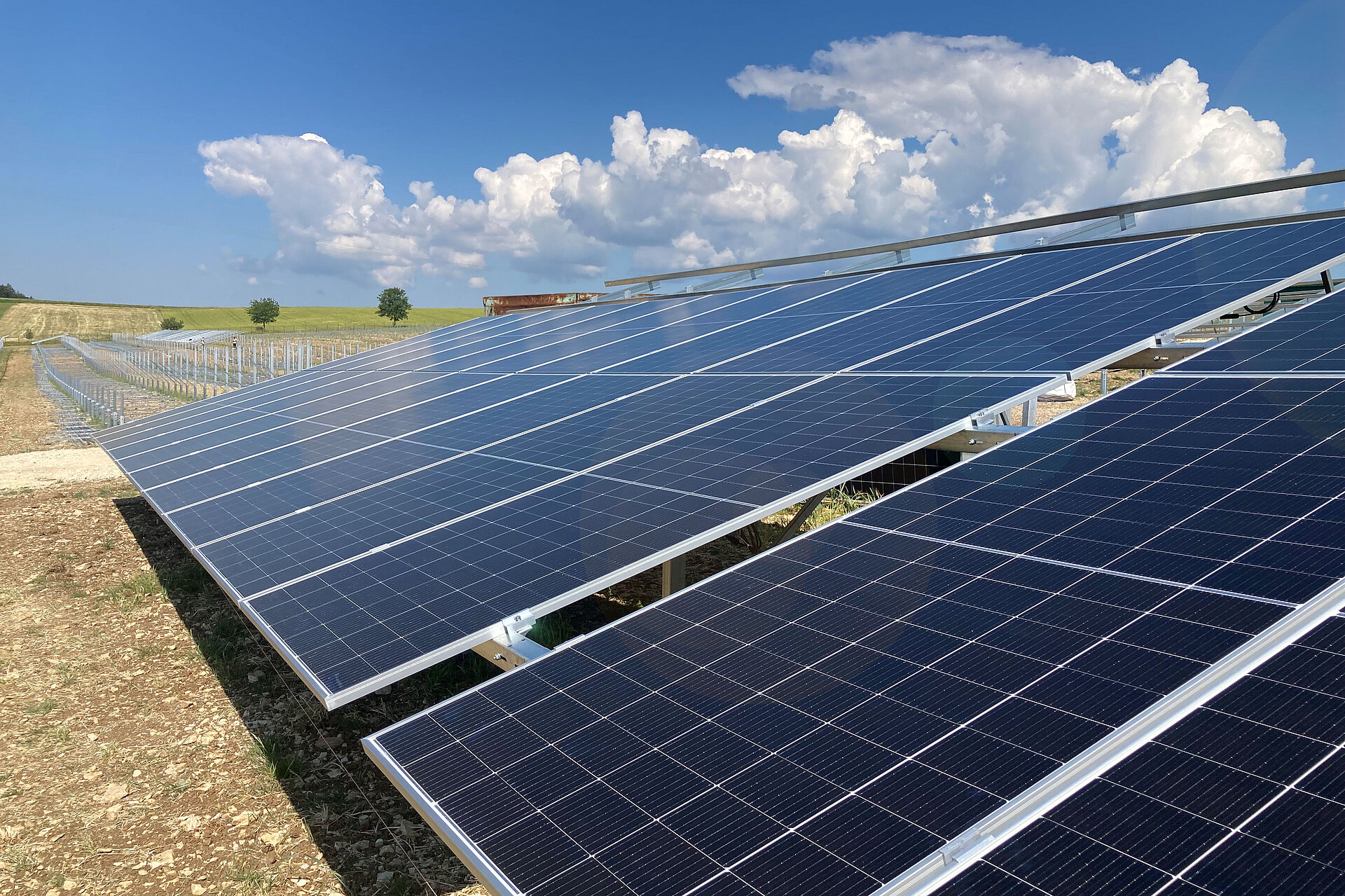
8 facts about ground-mounted photovoltaics
What you need to know about the costs, energy output and locations of solar parks
Renewable energy: the topic of the day. There are many types of renewable energy, from wind power to hydropower. One of the most attractive types is ground-mounted photovoltaics. Ground-mounted PV systems have great potential to generate environmentally friendly energy. In this article we explain: Costs, energy output and locations of solar parks. Discover the full potential of the sun with us!
1. Ground-mounted photovoltaic system explained
2. The advantages of ground-mounted PV? Clear as daylight!
3. What needs to be considered for a ground-mounted PV system?
4. Where may ground-mounted PV systems be built?
5. What different types of ground-mounted photovoltaic systems are there?
6. How much solar energy can be generated on a one-hectare plot of land?
7. What does 1 hectare of ground-mounted photovoltaics cost?
8. To what extent is biodiversity affected by photovoltaics on open spaces?
1. Ground-mounted photovoltaic system explained
Ground-mounted photovoltaics is an extremely efficient method of generating renewable electricity. With this technology, solar systems are installed on open spaces on the ground, such as unused agricultural land or fallow fields. These are particularly suitable for the installation of photovoltaic systems as they offer sufficient space to generate high yields of solar power.
2. The advantages of ground-mounted PV? Clear as daylight!
On the one hand, such plants can generate renewable electricity at an extremely favourable price, which in many cases is even lower than the price of conventional coal or gas-fired power plants. Secondly, they produce emission-free electricity and therefore make a significant contribution to climate protection.
In addition, the utilisation of open spaces for photovoltaic systems offers further advantages. For example, conversion areas, i.e. former industrial or commercial sites, can be revitalised and put to good use. Fallow or unused areas can also be revitalised by installing photovoltaic systems.
In brief:
- Reduced dependence on limited fossil fuels
- Reduction of greenhouse gases through electricity generation without the emission of climate-damaging carbon dioxide (CO2)
- Decentralised energy generation, as solar parks can be built anywhere where there is sufficient sunlight (geographical location, climate, shading, etc.)
- Technological advancement through the global use of solar energy (e.g. optimised output of solar modules on the same surface area)
3. What needs to be considered for a ground-mounted PV system?
It is important to note that the choice of location for ground-mounted photovoltaic systems must be made carefully. Optimum orientation of the systems towards the sun, consideration of areas without shading and examination of the legal framework are just some of the aspects that need to be taken into account when planning and realising such systems. Here are the most important points for you to consider:
- Site selection: Factors such as the availability of sufficient sunlight, favourable soil conditions, sufficient space for installing the solar modules and a good connection to the electricity grid must be taken into account.
- Soil expertise: A soil survey is important to analyse the nature of the soil. It helps to determine whether the ground is stable enough for the module tables or whether additional measures are required to secure it.
- Shading: A detailed analysis of the shading is important to ensure that the solar modules are shaded as little as possible. Shading can affect the yield of the system, so obstacles such as trees, buildings or other structures should be taken into account.
- Alignment and inclination of the modules: The orientation of the solar modules should be optimal in order to capture the maximum solar energy. As a rule, the modules are orientated to the south, east or west to ensure optimum solar radiation. The inclination of the modules should be adjusted depending on the geographical latitude.
- Authorisations and legal aspects: It is important to observe all necessary authorisations and legal regulations that apply to the construction and operation of a ground-mounted PV system. These include environmental regulations, building permits and grid connection regulations.
- Maintenance and servicing: Regular maintenance and monitoring of the system is important to maintain efficiency and optimum performance. This includes cleaning the solar modules, checking the cabling and inspecting the components.
Our tip: Realise your solar project with experienced PV experts to achieve maximum yields.

Ground-mounted photovoltaics is an extremely efficient method of generating renewable electricity.
4. Where may ground-mounted PV systems be built?
There are many different locations in Germany where ground-mounted photovoltaic systems can be built. However, not all sites are equally suitable. A suitable site should have the following three characteristics:
- High solar radiation: This is mainly found in sunny regions and areas with little shade. The latter requires a certain distance from buildings, forests and tall objects.
- A flat surface (as far as possible): A flat topography is an advantage, as an even alignment of the modules reduces shading. This reduces the technical requirements for planning and installation. In addition, a higher energy yield is possible if all PV modules are at the same height. Subsequent maintenance work is also easier to carry out.
- Good infrastructure: Proximity to the electricity infrastructure is important in order to feed the solar power generated into the grid with as few losses as possible. The feed-in point itself should have sufficient feed-in capacity.
According to the Renewable Energy Sources Act (EEG), disadvantaged areas are particularly suitable for the construction of solar parks, which is why they receive subsidies.
- Conversion areas: These are former industrial or commercial areas that can be converted and used for the construction of ground-mounted PV systems.
- Brownfield sites: These are unused or neglected areas that can be revitalised for ground-mounted PV systems.
- Landfill sites: Closed landfill sites offer an opportunity to generate renewable energy and at the same time reuse unused land.
- Transport areas: These are located along motorways and railways and can be used efficiently for ground-mounted PV systems, as they often offer extensive space.
- Agricultural land: Vacant land on agricultural land can be used for ground-mounted PV systems without affecting the primary use of the land.
5. What different types of ground-mounted photovoltaic systems are there?
Depending on the country, location and climate, it is decided how the maximum yield can be obtained from open areas. In general, a distinction can be made between fixed ground-mounted photovoltaic systems and systems with a tracker substructure. There are also special designs, such as agrivoltaic systems (agri-PV for short) and floating solar parks. Find out more about the different types of solar parks here.
6. How much solar energy can be generated on a one-hectare plot of land?
The energy output of a PV system depends on many factors, such as location, orientation and module type (e.g. size of the solar modules). In Germany, the average production output per square metre is around 100 watts. A 1 MWp ground-mounted PV system on one hectare (10,000 square metres) can generate around 1,000,000 kWh of clean energy per year. This corresponds to the annual energy consumption of around 235 average households. A solar park is therefore not only an environmentally friendly source of energy, but also a worthwhile investment.
7. What does 1 hectare of ground-mounted photovoltaics cost?
With SENS, you can realise your solar park from a system size of 10 hectares. The costs are calculated as follows.
The current costs (as of December 2023) for a ground-mounted photovoltaic system in Germany are between 480 and 520 euros per kilowatt peak (kWp). The average price for a 10 MWp solar park is therefore around 5 million euros. For 1 hectare (10,000 square metres), you can therefore expect to spend around 0.5 million euros.
1 kWp = 480 to 520 euros
1 hectare = approx. 1 MWp = 1,000 kWp
10,000 kWp * 500 euros = 5,000,000 euros (5 million euros)
The larger the PV system, the lower the costs per kWh. However, it is important to note that the costs for servicing and maintaining the system must also be taken into account.
8. To what extent is biodiversity affected by photovoltaics on open spaces?
Biodiversity is the variety of animal and plant species on earth. It is threatened by excessive agriculture (monocultures, pesticides), increasing environmental pollution and climate change, among other things. A study by the German Federal Association of the New Energy Economy (BNE) has analysed the synergy effects between ground-mounted photovoltaic systems and the conservation of native flora and fauna. The study has shown that solar parks have a significantly higher biodiversity than control areas. This is mainly due to the sowing of wildflowers and other measures to promote biodiversity.
Solar ground-mounted systems: the summary
Ground-mounted photovoltaics offers a great opportunity to produce renewable energy efficiently and contribute to the energy transition. The revitalisation of unused or fallow land not only generates renewable electricity, but also opens up new perspectives for the sustainable use of our land resources. The investment costs may seem high at first, but the investment pays off in the long term. This is because a ground-mounted PV system has a service life of around 30 years, with amortisation after 15 to 20 years. Worthwhile for your own wallet and the environment - for a future with 100% Good Energy.
Do you have a vacant plot of land and would like to use it to generate energy? Then find out now about your options for leasing land for PV.
Images: SENS
Published: 9 January 2024
Free area available?
We lease your area and implement photovoltaic systems.
Lease your land for photovoltaics and build solar parks for the energy transition. From a size of more than five hectares, SENS
will realise your PV project and provide you with a fixed income
for the next 30 years.
